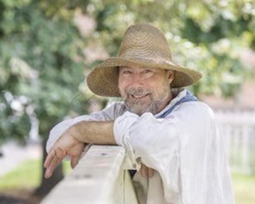Although wheat was not grown this year at Colonial Williamsburg, this series of captioned photos over the previous years can show you the processes of that crop. Enjoy the photos!
Ground Preparation begins with plowing. We use a reproduction of an 18th century barshare plow.

Bob Powell - noted plow scholar from Scotland - plows one of the first furrows with the barshare plow in 2008.
Depending on the nature of the soil, the plow can be pulled by oxen or a single horse.

Farmer Levi Walker plowing on medium heavy ground with a team of oxen.

Ed Schultz plowing on light soil with a single horse.

An example of the nice work that the barshare can do if the grass is light.

Sometimes we get visitors to help us.
Once plowed, the land must be harrowed to break up the soil to a finer state.

Shown is a reproduction harrow based on a drawing in George Washington’s 18th century diary who based it on agricultural innovator Arthur Young description.

We typically use a single horse to harrow. Ed Schultz harrowing with Lancer the horse.

Sometimes a lighter harrow is used to smooth the surface out. Kevin Tobias harrowing with Eli the horse.

Sometimes we pull it with oxen but find it to slow to break dirt clogs up efficiently.
We then broadcast the seed by hand using a sweeping motion.

Ed Schultz broadcasts wheat seed. A steady walk in a straight line is necessary to get good coverage.
We then harrow this seed into the ground with a light harrow. It comes up and winters over and about the middle of June it is time to cut with a sickle.

Sickle used to cut wheat
A handful of wheat is grasped to create tension on the stalk and in a quick motion the straw is severed.

Matt Sanbury cuts wheat with a sickle.

This photo shows the typical width of the cutting swath.
The handfuls of cut wheat are set aside and then gathered into a sheaf.

Jen Myrva gathering wheat. Photo by Fred Blystone.
The gathered wheat is then tied into a sheaf with a special knot.

Ed teaches Daniel Cross how to tie a sheaf. This is barley, but the knot is the same.
The sheaves are then put into shocks of around 10 sheaves to dry.

Sheaves placed in shocks to dry.

Sheaves placed in shocks to dry.
Once dry, the sheaves are put into a stack.

Stack of wheat.
When other agricultural work slows down then it is time to thresh the wheat with a flail.

Cameron Green threshes wheat. Photo by Fred Blystone.
Once all the wheat is removed from the straw with the flail, it is passed through a riddle (sometimes called a sieve) to separate the seed from the chaff.

Terry Thon holds a shear on the left while on the right Wayne Randolph holds a riddle.
Thanks for looking at the review of our wheat program at Colonial Williamsburg! Please reach out if you have any questions.

About the Author: Ed Schultz is Master Historic Farmer at Colonial Williamsburg. He has farmed at Living History sites in the 18th, 19th, and early 20th century. Ed has a small subsistence farm at home where he raises food and livestock with his family.
E-Mail: eschultz@cwf.org

Comments